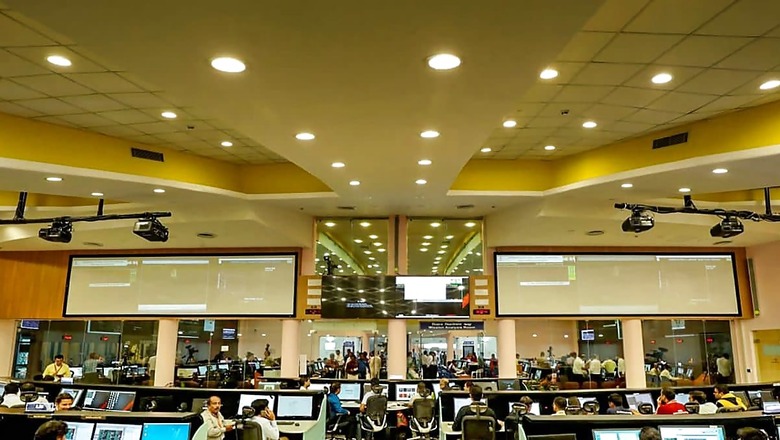
views
Three hundred and eighty-nine foreign satellites took-off in the last nine years — nearly 90% of what India launched since Independence, a nearly 150% jump in the budget for the space sector since 2013-14, and reaching Mars – India’s space sector story under the Narendra Modi government is as remarkable as its quest for Moon.
LIVE: Chandrayaan 3 Just Hours Away From Moon Landing
As India aims to create history on Wednesday by becoming the first country to land on the South Pole region of the Moon, it comes on the back of some historic reforms done by the Modi government and the constant support to the scientists at Indian Space Research Organisation (ISRO) to not lose heart from setbacks such as Chandrayaan-2 in 2019, and learn from it to achieve greater goals.
The foresightedness shows in the fact that in June 2023, shortly before the scheduled Chandrayaan-3 launch, India also signed on to the NASA-led Artemis Accords aiming for peaceful human and robotic exploration of the Moon. “The data from Chandrayaan-3 may be useful for future Artemis human landings too,” a government source has told News18.
Prime Minister Narendra Modi and junior minister of science and technology Jitendra Singh, who also holds the charge of MoS Prime Minister’s Office, have been constantly monitoring the progress at ISRO. The political will has helped the scientists to excel without constraints of budget.
Government sources say one big change has been the involvement of the private sector in helping ISRO innovate while the government plays the role of an “enabler” and removes any bottlenecks in ISRO’s quest.
While only 35 foreign satellites were launched by India pre-2014 compared to 389 foreign satellites sent to space under the Modi government, earning India over Rs 3,300 crore. Around 104 satellites were launched in one go in 2017. This means that the yearly launch missions increased from just 1.2 before 2014 to 5.7 in the last nine years. A highlight was the success of India’s Mars Orbiter Spacecraft in September 2014, putting India into a league of select nations, which sent a spacecraft to Mars.
Money Counts
The big changes have also come from the increase in budgetary allocation to the Department of Space from Rs 5,615 crore in 2013-14 to Rs 12,543.91 crore in 2023-24, as per budget documents.
The government decided to focus on six guiding principles — enabling and promoting private enterprises, carrying out independent space activities, opening up ISRO infrastructure and technologies, allowing public sector to focus on research and development work, pursue a demand-driven approach for development of space assets and inspire youngsters and dreamers. The Indian Space Policy, 2023 was approved for enhanced participation of non-government entities across the entire value chain of the space economy.
The Indian Space Association (ISpA) was formed along with IN-SPACe to ensure greater private participation in India’s space activities while the New Space India Limited was formed in 2019 as the commercial arm of ISRO for promotion and commercial exploitation of the products and services emanating from the Indian space programme. All this effort from the government has helped in space start-ups growing to 140 as on July 2023 from just a couple before 2014.
The Results
The big achievements cited by the Modi government are launching AstroSat, India’s first dedicated Space Astronomy Observatory and the ongoing development of Aditya-L1, the first observatory-class space-based solar mission from India.
ISRO has also developed Small Satellite Launch Vehicle (SSLV) to cater the launch of up to 500 kg satellites to Low Earth Orbits on ‘launch-on-demand’ basis. The first experimental mission of ISRO’s Scramjet Engine towards the realisation of Air Breathing Propulsion System was also successfully conducted in 2016. India’s first privately made rocket Vikram-S, developed by Skyroot Aerospace Private Limited, Hyderabad, was also set in motion in 2022 as well. After being mooted by Prime Minister Narendra Modi at 18th SAARC summit, ISRO also launched a communication satellite in 2017 to support neighbouring countries.
Frontiers Ahead
India’s next ambitious project is the Gaganyaan Mission for which ISRO has developed a spacecraft for carrying astronauts to space. The project is being primarily executed by Human Space Flight Centre (HSFC), which was constituted in January 2019 in ISRO to implement the Human Space Flight Programme. Gaganyaan envisages demonstration of human spaceflight capability by sending a three-member crew to an orbit of 400 km for three days and bring them back safely to Earth by landing in Indian sea waters.
After the much hopeful Chandrayaan-3 landing, the Indian space mission is aiming bigger.

















Comments
0 comment